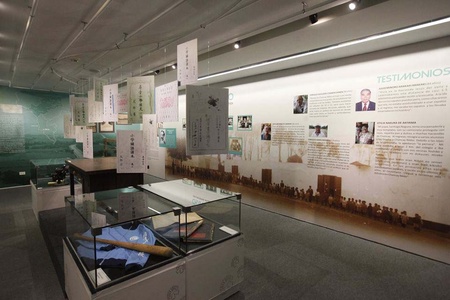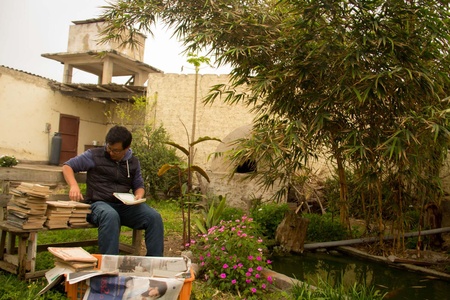The history of the Japanese-Peruvian community has many chapters, although some have been lost in the memories of the immigrants who arrived to work on the plantations of northern Peru without knowing how to speak Spanish. Many of them kept their memories to themselves. Interestingly, Japanese schools are a crucial element for understanding those times and how the first generations of Nikkei were educated.
In 2017, the Chancay Nikko school has played a key role in two important events that have helped recover the history of the oldest Japanese-Peruvian school in the northern part of the country. The first is an exhibit in May at the Carlos Chiyoteru Hiraoka Museum of the Japanese Immigration, with photographs and objects from this place in the Lima region. The second is a documentary by Onigiri Producciones, which has received funding from Japan.

“Rubén Sugano came up with the idea; he is an Uchina Goodwill Ambassador and we had worked together previously, on the documentary “Odori, 110 Years of History and Tradition in Peru (1906-2016),” says Onigiri's Gerardo Higa, who has also worked with Rubén on digital Nikkei television channels. In the previous video, they told the story of four teachers of Okinawan dance.
One detail of this 47-minute film is that it contains Japanese subtitles, because it was partly financed by the Okinawa International Exchange and Human Resources Development Foundation, just like the second documentary. This support made the project possible. “The Chancay Nikko school was in an area of Huaral that I passed by every day, and I didn’t even know that I had a chest full of things from the school at home,” Rubén says.
Thus, the project was born from the desire to retrieve the stories of the few students of that school who were still around.
School memories
The history of the Chancay Nikko school is a peculiar one. It was founded on April 20, 1924, near Makatón Hill, due to its resemblance to Mount Fuji. But it wasn't a public school, since it was located on the Esquivel plantation. “At my house I found a flag, books in Japanese, a blackboard and even a wooden table that I used,” says Rubén. His family lived on that plantation, which had been established by Amador del Solar Cárdenas, who served as Minister of Government and Police and president of the Senate.

Amador Del Solar, great-grandfather of the current Culture Minister, Salvador del Solar, had been a diplomat in Japan and brought people from there to work on his plantation. In fact, at the Chancay Nikko there was a bust of this illustrious character to honor his support for immigrants. Rubén's grandfather was an executive at the school, but he only remembers the summer trips they took to the beach, until the late 1980s.
What remains of that school, where more than 180 students were educated and which even had its own power plant, well for drinking water and theater, are parts of the foundation and a house that belonged to the teachers who came from Japan, such as Ginyu Igei and Yoho Adaniya. The cotton plantation, which also had an oil and soap factory, is now just a small farm.
“Thinking about Chancay Nikko brings to mind many wonderful memories. We studied in the morning and the afternoon. We also went to the school on Saturdays from 10 to 12, but just to clean. I also remember that there was a plot of land where every class had a garden and we planted all kinds of vegetables,” recalls Enrique Shigueru Chinen Chinen, 80 years old, whose story was part of the museum exhibit.
Filming
“This documentary was more difficult to make than the last one,” says Gerardo Higa, “since it was about something that no longer exists.” To make the film, they interviewed people who were more than 80 years old, so retrieving memories was difficult. “What's important is that those students who are still with us are very proud of having studied there, where they were taught everything in Japanese and were the first to play baseball.”
One anecdote included in the documentary is the happiness of the former students upon recalling their school's victory over the baseball team of the Lima Nikko, the most emblematic Japanese-Peruvian school, to become the interscholastic champions. Another anecdote: The last class was never able to graduate due to Peru's declaration of war against Japan in 1941 in the context of World War II. This was also a reason why much of the material from the school was lost.
“It's not clear whether the school was closed because of the war or if it was a decision by the plantation owner or overseer,” says Gerardo. “We haven't been able to clarify that.” The photos and books helped reconstruct the history of the school, along with a short film they found of various scenes at the school, the arrival of a ship from Yokohama to Peru and other moments that have been digitalized for this documentary.
“There are boys doing radio taiso (calisthenics) with live music, using an organ. And there were big crowds at the baseball games,” Gerardo adds. On the day the school building was demolished, Rubén's grandmother saw a sack that was going to be destroyed and grabbed it. Inside was a Kodak 33 mm projector which is included in the exhibit, along with a baseball bat and the diploma that Tomiko Sugano received upon finishing first grade in 1938, among other items.

Recovering memory
Peru is home to the Place of Memory, Tolerance and Social Inclusion (Lugar de la Memoria, la Tolerancia y la Inclusión Social or LUM), a museum that serves as a space for reflection on the country's internal armed conflicts between 1980 and 2000. However, few remember that Japanese-Peruvians were the victims of abuse as a result of the declaration of war. One way to raise awareness of this is by talking to people who were alive during that time.
Many don't want to remember because they find it painful or simply because they are worried about what others will say. “By nature they are reserved people. The Issei can be remarkable figures, athletic champions or highly renowned, but they won't tell you anything if you don't ask them,” remarks Gerardo. For this documentary, the filmmakers interviewed about 10 people, and obtained some valuable testimony that required travel outside Lima. Some of the material was difficult to understand, as it was in an older form of Japanese or Uchinaguchi, the Okinawan language.
“We wanted to recover stories about the school for the new generations, the fourth generation, who may not even know that it existed,” says producer Gerardo Higa, who directed the film along with Gustavo Barreda Fudimoto. They began in January 2017 and hope to release the half-hour long documentary at the Okinawan Association of Peru in February 2018, and later present it at other Nikkei institutions and in Japan. “Knowing where you come from is important and our goal is to help more people learn about their roots,” adds Gerardo.

© 2017 Javier Garcóa Wong-Kit





